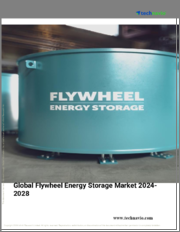
|
시장보고서
상품코드
1354291
세계의 플라이휠 에너지 저장 시장 규모 : 용도별, 성장 촉진요인, 예측(2023-2032년)Flywheel Energy Storage Market Size - By Technology (Adiabatic, Diabatic, Isothermal), By Application (On Site Power, Black Start, Electric Supply Capacity), Growth Drivers & Forecast, 2023 - 2032 |
||||||
세계 플라이휠 에너지 저장 시장은 재생 가능 에너지의 급속한 통합으로 인해 2023년부터 2032년까지 2.4%의 연평균 복합 성장률(CAGR)을 나타낼 것으로 예상됩니다.
풍력, 태양광 등 재생 가능 에너지의 도입 증가로 간헐적인 발전이 이루어지고 있습니다.
국제에너지기구(IEA)의 2022-2027년 재생에너지 전망(Renewable Power Forecast 2023)에 따르면, 재생에너지 용량은 2,400GW 가까이 증가할 것으로 예상됩니다. 이는 중국의 현재 총 설비용량과 맞먹는 규모다. 이는 지난 5년 대비 85%의 가속화를 의미하며, 작년 보고서에서 예측한 것보다 30% 가까이 높은 수치로, 역사상 가장 큰 상향 조정입니다. 플라이휠 에너지 저장 시스템은 발전 기간 동안 잉여 에너지를 저장했다가 필요할 때 방출하여 전력망 안정화에 기여합니다.
전체 플라이휠 에너지 저장 시장은 용도 및 지역에 따라 분류됩니다.
수송용 플라이휠 에너지 저장장치의 고유한 장점으로 인해 2023년부터 2032년까지 2.1% 시장 규모가 확대될 것으로 예상됩니다. 플라이휠은 빠른 에너지 회수 및 방전이 가능하기 때문에 전기 및 하이브리드 자동차의 회생 제동 시스템에 적합하여 에너지 효율과 주행거리를 향상시킵니다. 또한, 플라이휠의 내구성과 잦은 충방전 사이클을 견딜 수 있는 능력은 운송 용도의 요구사항에 부합합니다. 운송 산업이 전기화 및 지속가능성으로 전환함에 따라 플라이휠 에너지 저장 시스템은 이러한 목표를 달성하는 데 중요한 역할을 하며 높은 수요를 주도하고 있습니다.
아시아태평양의 플라이휠 에너지 저장 산업은 상당한 성장세를 보이고 있으며, 2032년까지 14.8% 이상의 성장률을 보일 것으로 예상됩니다. 전력망의 안정성과 신뢰성에 대한 필요성과 함께 재생 가능 에너지 프로젝트에 대한 투자가 증가함에 따라 플라이휠과 같은 에너지 저장 솔루션에 대한 수요가 증가하고 있습니다.
COP26에서 인도는 2030년까지 비화석연료 기반 에너지로 500GW를 달성하겠다는 야심찬 목표를 발표했습니다. 이 목표는 탄소 배출량을 줄이고 보다 지속 가능하고 친환경적인 에너지로 전환하기 위해 태양광, 풍력, 수력 등 재생 가능 에너지에 대한 대대적인 노력을 기울일 것을 의미합니다. 또한, 아시아태평양의 급속한 도시화와 산업화는 신뢰할 수 있는 백업 전원을 필요로 합니다. 빠른 응답과 에너지 효율로 유명한 플라이휠은 이러한 수요를 충족시키기에 적합하며, 이 지역의 강력한 산업 성장에 기여하고 있습니다.
목차
제1장 조사 방법과 조사 범위
제2장 주요 요약
제3장 플라이휠 에너지 저장 산업 인사이트
- 생태계 분석
- 벤더 매트릭스
- 규제 상황
- 업계에 대한 영향요인
- 성장 촉진요인
- 업계의 잠재적 리스크&과제
- 잠재 성장력 분석
- Porter's Five Forces 분석
- PESTEL 분석
- 업계 전망에 대한 COVID-19의 영향
- 전체상
제4장 경쟁 벤치마킹
- 혁신과 지속가능성 상황
- 경쟁 구도, 2022년
- 전략 대시보드
제5장 플라이휠 에너지 저장 시장 : 용도별
- 주요 동향
- 유틸리티
- 운송
- 방위 및 항공우주
- 기타
제6장 플라이휠 에너지 저장 시장 : 지역별
- 주요 동향
- 북미
- 미국
- 캐나다
- 유럽
- 독일
- 영국
- 프랑스
- 이탈리아
- 스페인
- 러시아
- 아시아태평양
- 중국
- 일본
- 인도
- 한국
- 호주
- 세계 기타 지역
제7장 기업 개요
- Langley Holdings plc
- Amber Kinetics, Inc.
- POWERTHRU
- STORNETIC GmbH
- Adaptive Balancing Power GmbH
- Energiestro
- VYCON
- Bc New Energy(Tianjin) Co., Ltd.(BNE)
- PUNCH Flybrid
- OXTO Energy
Global Flywheel Energy Storage Market will record 2.4% CAGR between 2023 and 2032, driven by the rapid integration of renewable energy. The increasing adoption of renewable energy sources, such as wind and solar, creates intermittent power generation.
According to Renewable Power Forecast 2023 by the International Energy Agency for the period 2022-2027, renewable energy capacity is expected to increase by nearly 2,400 GW. To put this in perspective, it's equivalent to China's current total installed power capacity. This represents an 85% acceleration compared to the previous five years and is nearly 30% higher than what was predicted in last year's report, marking the most significant upward revision in our history. Flywheel energy storage systems help stabilize the grid by storing excess energy during periods of generation and releasing it when needed.
The overall flywheel energy storage market is classified based on application and region.
The transportation segment size will expand at 2.1% over 2023-2032, owing to the unique advantages of flywheel energy storage in transportation applications. Flywheels offer rapid energy recovery and discharge, making them ideal for regenerative braking systems in electric and hybrid vehicles, enhancing energy efficiency and range. Additionally, their durability and ability to withstand frequent charge-discharge cycles align with the demands of transportation use. As the transportation industry shifts towards electrification and sustainability, flywheel energy storage systems play a vital role in meeting these goals, driving their high demand.
Asia Pacific Flywheel Energy Storage Industry is experiencing substantial growth and could exhibit over 14.8% through 2032. Increasing investments in renewable energy projects, in line with the need for grid stability and reliability, have driven demand for energy storage solutions like flywheels.
At COP26, India unveiled an ambitious goal, aiming to achieve 500 GW of non-fossil fuel-based energy by 2030. This target signifies a substantial commitment to renewable energy sources such as solar, wind, and hydroelectric power, as the country seeks to reduce its carbon footprint and transition towards a more sustainable and eco-friendly energy landscape. Moreover, Asia Pacific's rapidly expanding urbanization and industrialization require dependable backup power sources. Flywheels, known for their quick response and energy efficiency, are well-suited to meet these demands, contributing to the industry's robust growth in the region.
Table of Contents
Chapter 1 Methodology & Scope
- 1.1 Market scope and definitions
- 1.2 Base estimates & calculations
- 1.3 Forecast calculations
- 1.4 Data sources
- 1.4.1 Primary
- 1.4.2 Secondary
- 1.4.2.1 Paid sources
- 1.4.2.2 Public sources
Chapter 2 Executive Summary
- 2.1 Flywheel energy storage industry 360 degree synopsis, 2019 - 2032
- 2.1.1 Business trends
- 2.1.2 Application trends
- 2.1.3 Regional trends
Chapter 3 Flywheel Energy Storage Industry Insights
- 3.1 Industry ecosystem analysis
- 3.1.1 Vendor matrix
- 3.2 Regulatory landscape
- 3.3 Industry impact forces
- 3.3.1 Growth drivers
- 3.3.2 Industry pitfalls & challenges
- 3.4 Growth potential analysis
- 3.5 Porter's Analysis
- 3.5.1 Bargaining power of suppliers
- 3.5.2 Bargaining power of buyers
- 3.5.3 Threat of new entrants
- 3.5.4 Threat of substitutes
- 3.6 PESTEL Analysis
- 3.7 COVID- 19 impact on the industry outlook
- 3.7.1 Overall view
Chapter 4 Competitive Benchmarking
- 4.1 Innovation & sustainability landscape
- 4.2 Competitive landscape, 2022
- 4.2.1 Strategy dashboard
Chapter 5 Flywheel Energy Storage Market, By Application
- 5.1 Key application trends
- 5.2 Utility
- 5.3 Transportation
- 5.4 Defense & aerospace
- 5.5 Others
Chapter 6 Flywheel Energy Storage Market, By Region
- 6.1 Key regional trends
- 6.2 North America
- 6.2.1 U.S.
- 6.2.2 Canada
- 6.3 Europe
- 6.3.1 Germany
- 6.3.2 UK
- 6.3.3 France
- 6.3.4 Italy
- 6.3.5 Spain
- 6.3.6 Russia
- 6.4 Asia Pacific
- 6.4.1 China
- 6.4.2 Japan
- 6.4.3 India
- 6.4.4 South Korea
- 6.4.5 Australia
- 6.5 Rest of World
Chapter 7 Company Profiles
- 7.1 Langley Holdings plc
- 7.2 Amber Kinetics, Inc.
- 7.3 POWERTHRU
- 7.4 STORNETIC GmbH
- 7.5 Adaptive Balancing Power GmbH
- 7.6 Energiestro
- 7.7 VYCON
- 7.8 Bc New Energy (Tianjin) Co., Ltd. (BNE)
- 7.9 PUNCH Flybrid
- 7.10 OXTO Energy

















